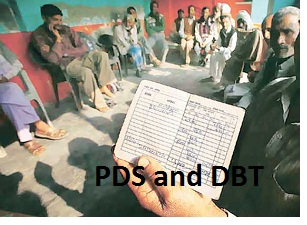CURRENT AFFAIRS
Get the most updated and recent current affair content on Padhaikaro.com
Advantages of PDS and DBT: A Comparison
- IAS NEXT, Lucknow
- 12, Jan 2021

Disadvantage of PDS and DBT : A Comparison

The National Food Security Act
The NFSA was passed in the Parliament in the year 2013, the NFSA seeks to provide the food to all individuals by making it a statutory right.
A comparison of existing TDPS and NFSA
| Scope | TPDS | NFSA |
| Legal Status | An Anti-Poverty Programme with no legal backing. | Passed by the Parliament with the statutory backing for “Right to Food”. |
| Coverage | Restricted to the Poor BPL Households. APL families can get grains from ration shops but not at subsidised prices. | Up to 75% of the rural population and 50% of the Urban population are included. Total coverage is 67.5% of all Population. |
| Categorisation | AAY households, BPL Families and APL families. | AAY Households, Priority Households and Excluded Households. |
| Entitlements |
BPL and AAY: 35 KG/FAMILY/MONTH. APL: 15-35 KG/Family/Month |
Priority HHs: 5 KG/Person/Month AAY HHs: 35 KG/Family/Month |
| Prices |
AAY HHs: RS 3/KG of Rice RS 2/KG of Wheat RS 1/KG of Coarse Grains |
All Categories: RS 3/KG of Rice RS 2/KG of Wheat RS 1/KG of Coarse Grains |
| Identification |
Cooperative Structure with Centre creating identifying criteria for the poor household using poverty and consumption estimates. States are responsible for identifying eligible households. |
Cooperative Structure with Centre realising the state wise estimates of the household to be covered under the NFSA. States are responsible for creating criteria and identifying eligible households. |
| Role of Centre and State |
Centre: Procurement at MSP and Distribution and Transportation through FCI. State: Delivery of grains to final beneficiaries through ration shops. |
Centre & State: Some provisions are same as with TPDS. Except that centre will provide food security allowances to states to pass on to the beneficiaries. State and Centre are not responsible to supply food grains during the time of natural calamities like flood and drought. |
| Grievances | States are responsible for monitoring and vigilance at district and block level. |
District grievances redressal officers will be appointed; Establishment of the State Food Commissioners; Vigilance committees at district and block levels. |
(d) Agriculture Marketing
Marketing of Agricultural Produce in India: Definition; Role; APMC Act, Model APMC Act, 2003
Agricultural Marketing in India
Definition:
In a very narrow sense, Agriculture marketing means delivering farm product from farmers to the final consumers. The National Commission on Agriculture defined agricultural marketing as a process which starts with a decision to produce a saleable farm commodity, and it involves all aspects of market structure of system, both functional and institutional, based on technical and economic considerations and includes pre- and post-harvest operations, assembling, grading, storage, transportation and distribution.
The Broader role of Agriculture Marketing in India.

The prerequisites to attain these goals are:

These conditions cannot come up on their own, particularly in a developing country like India. Therefore, agricultural market policies are treated as an integral part of development policies and their functioning has remained an important part of public policy in India.
Government Intervention in Agriculture Markets
Policy interventions in agricultural markets in India have a long history. Till the mid-1960s, it was mainly meant to facilitate the smooth functioning of markets and to keep a check on hoarding activities that were considered unfriendly to producers and/or consumers.
Subsequently, the country opted for a package of direct and indirect interventions in agricultural markets and prices, initially targeted at procuring and distributing wheat and paddy. This gradually expanded to cover several other crops/products and aspects of domestic trade in agriculture.
The present policy framework for intervention in agricultural markets and prices can be broadly grouped under three categories –
- (a) regulatory measures;
- (b) market infrastructure and institutions; and
- (c) agricultural price policy.
Regulatory Measures
Regulatory measures include the development and regulation of wholesale markets in Indian; and, adoption of legal instruments for the regulation of agriculture marketing and trade.
Agriculture Produce Marketing Committee Regulation (APMC) Act.
All wholesale markets for agricultural produce in states that have adopted the Agricultural Produce Market Regulation Act (APMRA) are termed as “regulated markets”. With the exception of Kerala, J & K, and Manipur, all other states have enacted APMC Act.
The working of the APMC
The Act is implemented and enforced by APMCs established under it.
- It mandates that the sale/purchase of agricultural commodities notified under it are to be carried out in specified market areas, yards or sub-yards. These markets are required to have the proper infrastructure for sale of farmers’ produce.
- Prices in them are to be determined by open auction, conducted in a transparent manner in the presence of an official of the market committee.
- Market charges for various agencies, such as commissions for commission agents (arhtiyas); statutory charges, such as market fees and taxes; and produce-handling charges, such as for cleaning of produce, and loading and unloading, are clearly defined, and no other deduction can be made from the sale proceeds of farmers. Market charges, costs, and taxes vary across states and commodities.

